
Dorado is a constellation in the Southern Sky. It was named in the late 16th century and is now one of the 88 modern constellations. Its name refers to the mahi-mahi, which is known as dorado ("golden") in Spanish, although it has also been depicted as a swordfish. Dorado contains most of the Large Magellanic Cloud, the remainder being in the constellation Mensa. The South Ecliptic pole also lies within this constellation.

Sagittarius is one of the constellations of the zodiac and is located in the Southern celestial hemisphere. It is one of the 48 constellations listed by the 2nd-century astronomer Ptolemy and remains one of the 88 modern constellations. Its old astronomical symbol is (♐︎). Its name is Latin for "archer". Sagittarius is commonly represented as a centaur drawing a bow. It lies between Scorpius and Ophiuchus to the west and Capricornus and Microscopium to the east.

Messier 73 is an asterism of four stars in the constellation Aquarius. It lies several arcminutes east of globular cluster M72. According to Gaia EDR3, the stars are 1030±9, 1249±10, 2170±22, and 2290±24 light-years from the Sun, with the second being a binary star.

The Jewel Box is an open cluster in the constellation Crux, originally discovered by Nicolas Louis de Lacaille in 1751–1752. This cluster was later named the Jewel Box by John Herschel when he described its telescopic appearance as "... a superb piece of fancy jewellery". It is easily visible to the naked eye as a hazy star some 1.0° southeast of the first-magnitude star Mimosa. This hazy star was given the Bayer star designation "Kappa Crucis", from which the cluster takes one of its common names. The modern designation Kappa Crucis has been assigned to one of the stars in the base of the A-shaped asterism of the cluster.

Messier 103 is a small open cluster of many faint stars in Cassiopeia. It was discovered on 27 March 1781 by Pierre Méchain, but later added as Charles Messier's last deep-sky object in his catalogue.

NGC 225 is an open cluster in the constellation Cassiopeia. It is located roughly 2,200 light-years from Earth. It is about 100 to 150 million years old.
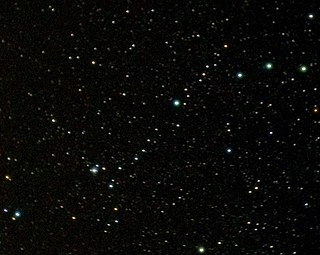
Kemble's Cascade is an asterism located in the constellation Camelopardalis. It is an apparent straight line of more than 20 colourful 5th to 10th magnitude stars over a distance of approximately 3 degrees of the night sky. It appears to "flow" into the compact open cluster NGC 1502, which can be found at one end.

NGC 1502 is a young open cluster of approximately 60 stars in the constellation Camelopardalis, discovered by William Herschel on November 3, 1787. It has a visual magnitude of 6.0 and thus is dimly visible to the naked eye. This cluster is located at a distance of approximately 3,500 light years from the Sun, at the outer edge of the Cam OB1 association of co-moving stars, and is likely part of the Orion Arm. The asterism known as Kemble's Cascade appears to "flow" into NGC 1502, but this is just a chance alignment of stars.

The Collinder catalogue is a catalogue of 471 open clusters compiled by Swedish astronomer Per Collinder. It was published in 1931 as an appendix to Collinder's paper On structural properties of open galactic clusters and their spatial distribution.
NGC 6738 is an astronomical feature that is catalogued as an NGC object. Although listed as an open cluster in some astronomical databases, it may be merely an asterism; a 2003 paper in the journal Astronomy and Astrophysics describes it as being an "apparent concentration of a few bright stars on patchy background absorption".

NGC 1807 is an asterism at the border of the constellations Orion and Taurus near the open cluster NGC 1817. NGC 1807 has an apparent size of 5.4' and an apparent magnitude of 7.0.
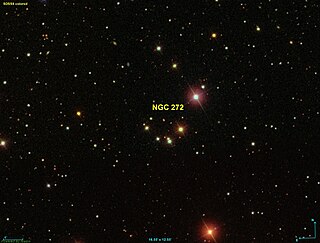
NGC 272 is an open cluster located in the constellation Andromeda. It was discovered on August 2, 1864, by Heinrich d'Arrest.
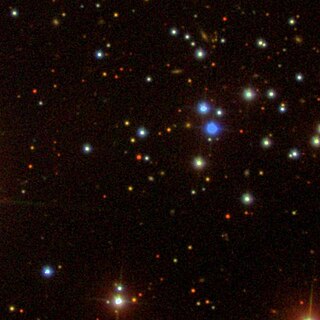
NGC 956 is an asterism in the constellation Andromeda.
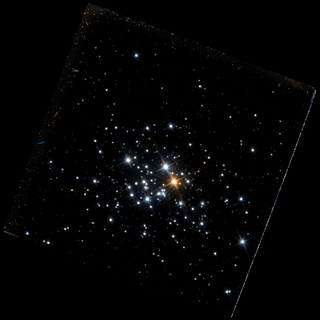
NGC 1984 is an open cluster associated with an emission nebula, it is located in the constellation Dorado in the Large Magellanic Cloud. It was discovered by John Herschel on 16 December 1835. The apparent magnitude is 9.9 and its size is 1.50 by 1.20 arc minutes.
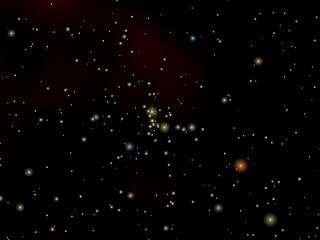
NGC 6910 is an open cluster in the constellation Cygnus. It was discovered by William Herschel on October 17, 1786. The cluster was also observed by John Herschel on September 18, 1828. It is a poor cluster with prominent central concentration and Trumpler class I2p. NGC 6910 is the core cluster of the stellar association Cygnus OB9.
NGC 6863 is an asterism in the constellation Aquila. The celestial object was found on July 25, 1827, by the British astronomer John Herschel.

The Melotte catalogue is a catalogue of 245 star clusters compiled by British astronomer Philibert Jacques Melotte. It was published in 1915 as A Catalogue of Star Clusters shown on Franklin-Adams Chart Plates. Catalogue objects are denoted by Melotte, e.g. "Melotte 20". Dated prefixes include as Mel + catalogue number, e.g. "Mel 20".
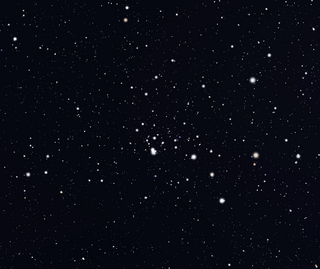
NGC 957 is a loosely bound open cluster located in the constellation Perseus. It has an apparent magnitude of 7.6 and an approximate size of 11 arc-minutes. It is young at less than 11 million years old.

NGC 2353 is a loosely bound open cluster located in the constellation Monoceros. It has an apparent magnitude of 7.1 and an approximate size of 20 arc-minutes. The cluster is dominated by the magnitude 6.0 star HIP 34999, which lies at the southern edge of the cluster.
This page is based on this
Wikipedia article Text is available under the
CC BY-SA 4.0 license; additional terms may apply.
Images, videos and audio are available under their respective licenses.


















